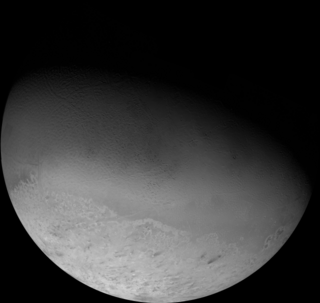
Triton is the largest natural satellite of the planet Neptune. It is the only moon of Neptune massive enough to be rounded under its own gravity and hosts a thin but well-structured atmosphere. Triton orbits Neptune in a retrograde orbit—an orbit in the direction opposite to its planet's rotation—the only large moon in the Solar System to do so. Triton is thought to have once been a dwarf planet, captured from the Kuiper belt into Neptune orbit.
Landforms are categorized by characteristic physical attributes such as their creating process, shape, elevation, slope, orientation, rock exposure, and soil type.

A cryovolcano is a type of volcano that erupts gases and volatile material such as liquid water, ammonia, and hydrocarbons. The erupted material is collectively referred to as cryolava; it originates from a reservoir of subsurface cryomagma. Cryovolcanic eruptions can take many forms, such as fissure and curtain eruptions, effusive cryolava flows, and large-scale resurfacing, and can vary greatly in output volumes. Immediately after an eruption, cryolava quickly freezes, constructing geological features and altering the surface.

Amazonis Planitia is one of the smoothest plains on Mars. It is located between the Tharsis and Elysium volcanic provinces, to the west of Olympus Mons, in the Amazonis and Memnonia quadrangles, centered at 24.8°N 196.0°E. The plain's topography exhibits extremely smooth features at several different lengths of scale. A large part of the Medusae Fossae Formation lies in Amazonis Planitia.
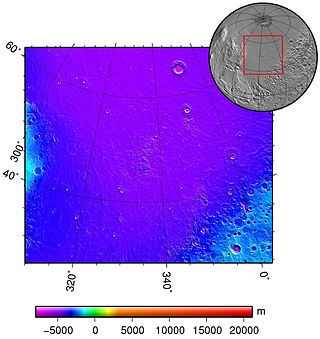
Acidalia Planitia is a plain on Mars, between the Tharsis volcanic province and Arabia Terra to the north of Valles Marineris, centered at 49.8°N 339.3°E. Most of this region is found in the Mare Acidalium quadrangle, but a small part is in the Ismenius Lacus quadrangle. The plain contains the famous Cydonia region at the contact with the heavily cratered highland terrain.
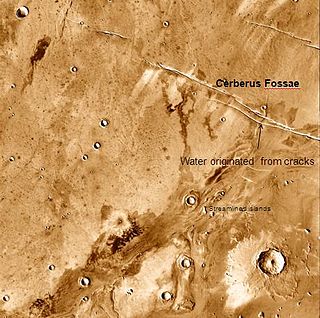
The Athabasca Valles are a late Amazonian-period outflow channel system in the central Elysium Planitia region of Mars, located to the south of the Elysium Rise. They are part of a network of outflow channels in this region that are understood to emanate from large fissures in the Martian surface rather than the chaos terrains that source the circum-Chryse outflow channels. The Athabasca Valles in particular emanate from one of the Cerberus Fossae fissures and flow downstream to the southwest, constrained to the south by a wrinkle ridge for over 100 km, before debouching into the Cerberus Palus volcanic plain. The Athabasca Valles are widely understood to be the youngest outflow channel system on the planet.

Sobkou Planitia is a large basin on the planet Mercury. It is named after the ancient Egyptian messenger deity Sobkou. He was associated by the Egyptians with the planet Mercury.
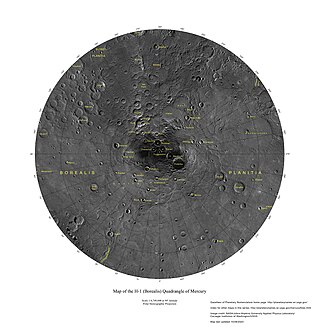
The Borealis quadrangle is a quadrangle on Mercury surrounding the north pole down to 65° latitude. It was mapped in its entirety by the MESSENGER spacecraft, which orbited the planet from 2008 to 2015, excluding areas of permanent shadow near the north pole. Only approximately 25% of the quadrangle was imaged by the Mariner 10 spacecraft during its flybys in 1974 and 1975. The quadrangle is now called H-1.

The Tolstoj quadrangle in the equatorial region of Mercury runs from 144 to 216° longitude and -25 to 25° latitude. It was provisionally called "Tir", but renamed after Leo Tolstoy by the International Astronomical Union in 1976. Also called Phaethontias.
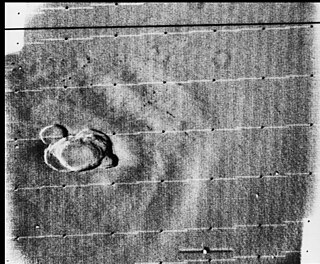
Volcanic activity, or volcanism, has played a significant role in the geologic evolution of Mars. Scientists have known since the Mariner 9 mission in 1972 that volcanic features cover large portions of the Martian surface. These features include extensive lava flows, vast lava plains, and the largest known volcanoes in the Solar System. Martian volcanic features range in age from Noachian to late Amazonian, indicating that the planet has been volcanically active throughout its history, and some speculate it probably still is so today. Both Mars and Earth are large, differentiated planets built from similar chondritic materials. Many of the same magmatic processes that occur on Earth also occurred on Mars, and both planets are similar enough compositionally that the same names can be applied to their igneous rocks.

Kraken Catena is a pit chain (catena) and likely tectonic fault on Triton, the largest natural satellite of Neptune. It, along with Set Catena, is located near and is aligned approximately radially from Leviathan Patera, a major cryovolcanic feature; as such, Kraken Catena may have played a role in rift-induced cryovolcanic activity in Leviathan Patera. Several of Kraken Catena's pits have central steep-sided knobs, giving a moated appearance similar to the moated mountains found on Pluto's moon Charon and Uranus's moon Ariel.

Guinevere Planitia is an expansive lowland region of Venus that lies east of Beta Regio and west of Eistla Regio. These low-lying plains, particularly in the western portion, are characterized by apparent volcanic source vents and broad regions of bright, dark, and mottled deposits. They are the only break in an equatorially connected zone of highlands and tectonic zones. The types, numbers, and patterns of mapped tectonic features and small volcanic landforms in the region provide important detail in the interpretation and evolution of venusian landscape.

Sputnik Planitia is a large, partially glaciated basin on Pluto. About 1,400 by 1,200 km in size, Sputnik Planitia is partially submerged in large, bright glaciers of nitrogen ice. Named after Earth's first artificial satellite, Sputnik 1, it constitutes the western lobe of the heart-shaped Tombaugh Regio. Sputnik Planitia lies mostly in the northern hemisphere, but extends across the equator. Much of it has a surface of irregular polygons separated by troughs, interpreted as convection cells in the relatively soft nitrogen ice. The polygons average about 33 km (21 mi) across. In some cases troughs are populated by blocky mountains or hills, or contain darker material. There appear to be windstreaks on the surface with evidence of sublimation. The dark streaks are a few kilometers long and all aligned in the same direction. The planitia also contains pits apparently formed by sublimation. No craters were detectable by New Horizons, implying a surface less than 10 million years old. Modeling sublimation pit formation yields a surface age estimate of 180000+90000
−40000 years. Near the northwest margin is a field of transverse dunes, spaced about 0.4 to 1 km apart, that are thought to be composed of 200-300 μm diameter particles of methane ice derived from the nearby Al-Idrisi Montes.

Vulcan Planitia, or Vulcan Planum, is the unofficial name given to a large plain on the southern hemisphere of Pluto's moon Charon. It discovered by New Horizons during its flyby of Pluto in July 2015. It is named after the fictional planet Vulcan in the science-fiction series Star Trek. The name is not approved by International Astronomical Union (IAU) as of 2024.

Wright Mons is a large, roughly circular mountain and likely cryovolcano on the dwarf planet Pluto. Discovered by the New Horizons spacecraft in 2015, it is located southwest of Sputnik Planitia within Hyecho Palus, adjacent to the Tenzing Montes and Belton Regio. A relatively young geological feature, Wright Mons has attracted attention as one of the most apparent examples of recent geological activity on Pluto and borders numerous other similarly young features. Numerous semi-regular hills surround and partially construct the flanks of Wright Mons. Their nature remains unexplained, with few, if any, direct analogs elsewhere in the Solar System.

Set Catena is a pit chain (catena) and likely tectonic fault located on Triton, the largest natural satellite of Neptune. It, along with Kraken Catena, is located near Leviathan Patera, a major cryovolcanic feature; as such, Set Catena may have played a role in rift-induced cryovolcanic activity in Leviathan Patera. Set Catena extends radially northwards from Leviathan Patera, terminating at another irregularly-shaped walled depression. Set Catena consists of semi-regularly spaced pits roughly 20 km separated from each other, with each pit being on average 10 km wide and up to 500 m deep. The pits may have formed from collapse or from explosive cryovolcanic eruptions, and may have been subsequently expanded by mass wasting processes. Set Catena may be a northeastern extension of Raz Fossae, a similar fault system southwest of Leviathan Patera.

Leviathan Patera is a major cryovolcanic caldera on Neptune's largest moon Triton. Discovered by the Voyager 2 spacecraft in 1989, Leviathan Patera is located in Monad Regio and within Cipango Planum's western regions. Leviathan Patera is approximately 80 kilometers in diameter and may be the center of one of the largest cryovolcanic or volcanic edifices in the Solar System.

The geology of Triton encompasses the physical characteristics of the surface, internal structure, and geological history of Neptune's largest moon Triton. With a mean density of 2.061 g/cm3, Triton is roughly 15-35% water ice by mass; Triton is a differentiated body, with an icy solid crust atop a probable subsurface ocean and a rocky core. As a result, Triton's surface geology is largely driven by the dynamics of water ice and other volatiles such as nitrogen and methane. Triton's geology is vigorous, and has been and continues to be influenced by its unusual history of capture, high internal heat, and its thin but significant atmosphere.
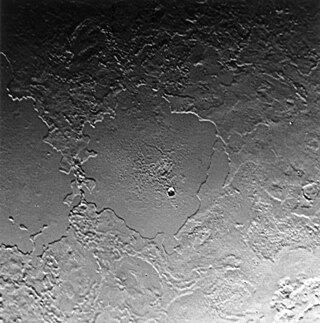
Ruach Planitia is a roughly circular flat plain and probable cryolava lake on Neptune's moon Triton. It is located in Triton's northern hemisphere within Monad Regio and directly borders the cryovolcanic plains of Cipango Planum to the east and Tuonela Planitia to the west. Ruach Planitia, along with the other three walled plains of Triton, is one of the youngest and flattest features observed on the moon.
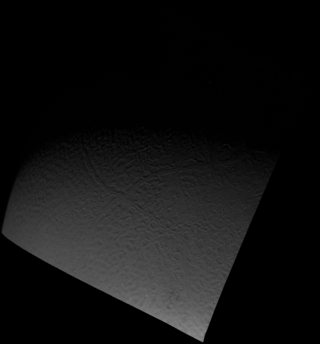
Slidr Sulci is a major tectonic fault on Neptune's largest moon Triton. It crosses a wide variety of terrains on Triton, most prominently the cantaloupe terrain, an unusually-textured region resembling the skin of a North American cantaloupe. The fault is named after the River Sliðr of Norse mythology, whose waters in Hel are filled with swords. The name Slidr Sulci was officially approved by the International Astronomical Union (IAU) in 1991. As with all of Triton's surface features, Slidr Sulci was first observed by the Voyager 2 spacecraft on its flyby of Neptune and Triton in 1989.


















